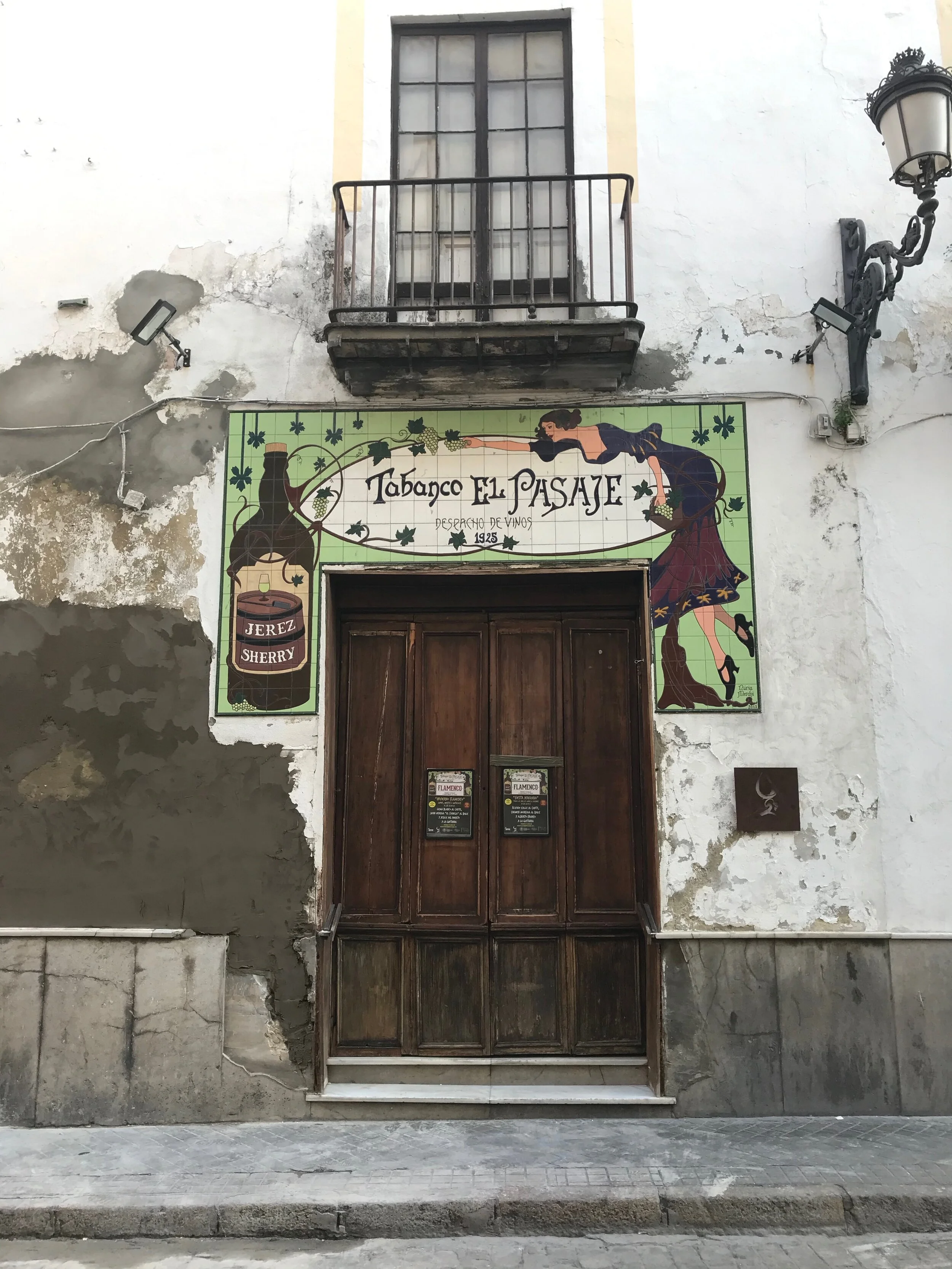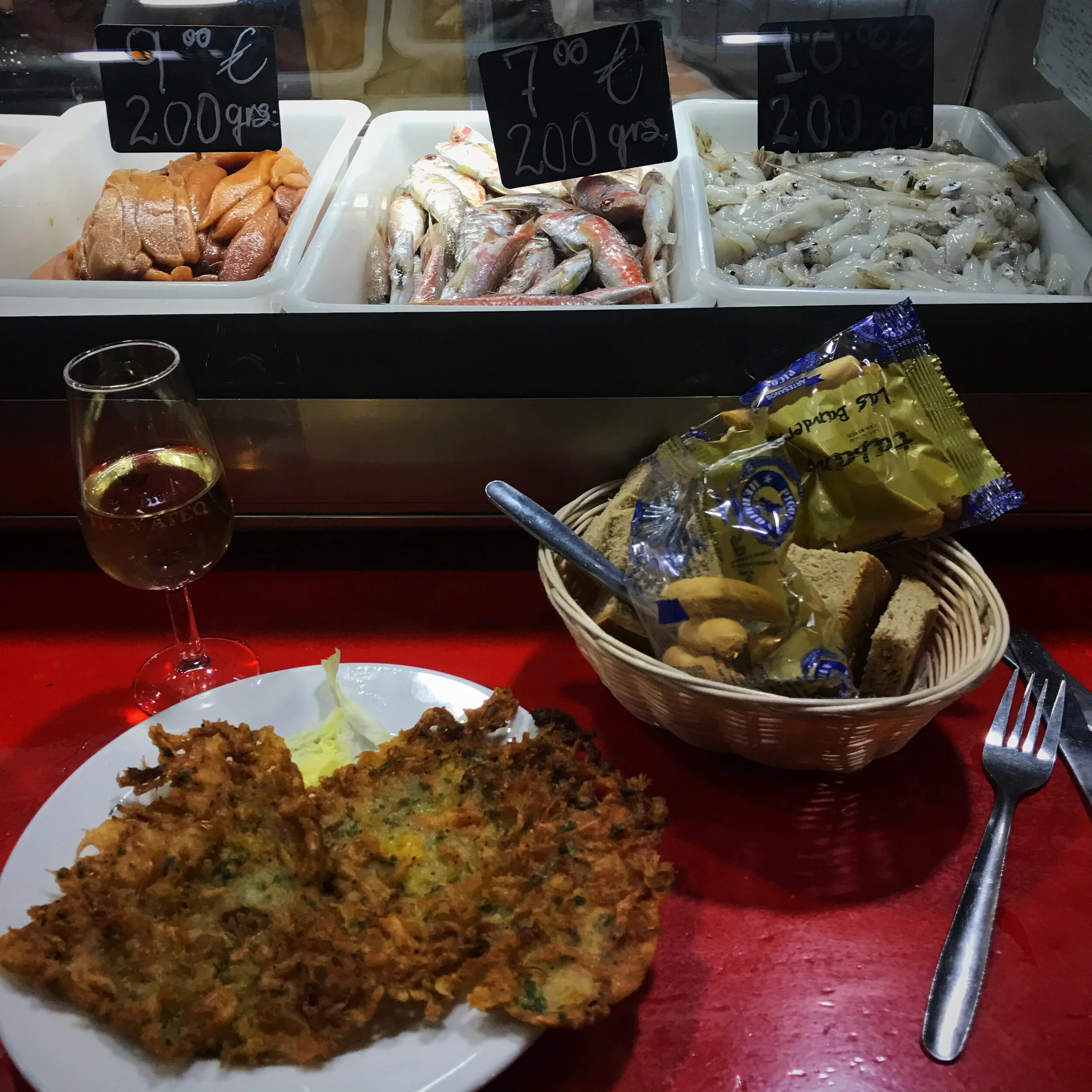A Tour of Tapas: Jerez Part II, Andalusian Nights
This is Part II, For Part I Click HERE
We awaken from our naps to a dimming sky over Jerez. Quickly gathering our things, we wander out, looking for a coffee and hoping to stumble onto a restaurant or two which weren’t closed for the season.
By night, the city seemed transformed: gas lamps flickered to life, their orange glow creating an aura of warmth in the dying light. In the town’s stone courtyards, the same which only a few hours ago had been desolate, voices rise along with the light. Mostly locals, enjoying coffees, churros and chocolate, and merrily celebrating a town which was theirs again for the season. Their reverie impossible to resist, we sit awhile.
Though it’s still early, the moon is big and high already. Its blue light mixes with the flickering lamps to cast a sort of magic across the plaza. Flamenco – not the percussive insistence of its rhythms but the singing, like impossible longing – drifts through the square from somewhere deep in the city. We’re drinking our cortados in the shadow of a mounted general cast in bronze. And the light and the music – the electricity in the air – made it seem as if his city was reverting back to the one he had known a century ago, if only for the night. We finished our coffees and bounded through the streets in giddy anticipation of our Andalusian night to come.
We took one delirious turn after the next, losing ourselves in Jerez’s network of twisting alleys and backstreets. Darkened passageways beckoned us into hidden sherry bars and flamenco dens. Hints of what we might find inside could be found hung near the entrances (and plastering most surfaces throughout Jerez): beautiful hand-painted flyers, like those used to advertise bullfights, promoting gypsy bands and flamenco seductresses. But whereas the reds and blacks of the matador translated violent heroics, the same striking colors here were sensual, red dresses and ebony hair painted in long sweeping strokes.
Caught up in a particularly stunning one of these, we barely notice the near-constant stream of people jostling past us to get to the nearby door. The poster’s spell broken, we look up now to find a tile sign above the entrance. It’s a mosaic the color of mint ice cream. A large brown bottle of Sherry dominates its left side. An elongated woman in purple (only just smaller than the bottle) leans from the right and across the top, suspended in a vine and reaching for a bunch of grapes hanging from the far side. Below her hovers the name of the bar, Tabanco El Pasaje, and below that, Despacho De Vinos, 1925.
We allow ourselves to be carried in by another wave of eager patrons and find ourselves standing at the far side of the bar. The space itself is comprised of three adjoining rooms forming a “U” shape; the bar bridging two parallel spaces with small stools and barrels for tables. Despite the crowds we’d seen coming in, the first of these rooms and most of the bar space were almost completely empty. Where had everybody gone?
We walk to the bar to order a drink. The space, unlike many of the others we’ve been to, is rather brightly lit, which I’m not sure we preferred. Photographs and sherry paraphernalia, all covered in almost a century of dust, hang in any available space on the walls. Every surface is shellacked in either evergreen paint or a dark wood stain, in some places looking a couple centimeters thick. It’s as if they repaint rather than clean any surface. Behind the bar a pyramid of huge barrels lie tapped and waiting for any of the half dozen Sherry orders from fino to [cream/crema]. We order some amontillados and the barman marks two tallies in chalk on the thick wooden bar top in front of us. Impulsively I add an order of potato chips, which here come plated and laced with thin slices of jamón. He adds to the tallies and we take everything over to the narrow sidebar which runs along the perimeter of the room.
Since we’ve arrived, still more people have filed in and begun a slow push towards the last section of the bar. Taking a quick peak, I discover where all the others have gone. Here, crammed into this small third of the bar, people sit or stand wherever they can find space. Every nook and ledge is filled in front of the small stage where now a small group dressed mostly in black rises to bated breath.
I turn back to Breezy who’s been waiting at our space around the corner. It’s decidedly less cramped but out of view of the stage. I’m about to suggest we enter the fray when she points out a huge gilded mirror raised in the corner above the sherry barrels. It’s positioned so that from anywhere in the crowded bar, the performers are visible through its warped glass.
We watch the four gypsies float ghost-like across the mirror and take their places on the stage. Two of the men sit slightly back, one with a guitar and one on a cajón. The other two, a woman and a man, both heavily made up and trailing colorful scarves and jet black hair to their waists, sit in front. As if one person, they take a breath and begin.
Slow chords and finger picking accompany pastoral four part harmonies which, in time, give way to the syncopated clapping, stomping, and snapping which is Flamenco’s bread and butter. The sound is impossibly rich for only four voices and eight hands. Spectral, the discomfiting cries of a lost soul and a broken country. Its build is agonizingly slow, a beautiful tension which you most desperately want resolved. It is loving and longing and loneliness. You can feel it in your bones but can’t quite shake it. The music won’t allow it.
By degrees, the relentless drive works the performers and spectators alike into a frenzy. No one is still. Everyone lost themselves long ago in the guitar and the voices, the music and images in the mirror seemingly worlds away from our dingy sidebar in Jerez. Hoots and cries of olé rise from the crowd, now desperate for catharsis. Finally, when no one can bear it any longer, and only then, the dance: a whirling dervish of stomping, flying hair (and hair-pins), and flailing limbs. A wild climax, sensual and violent and breathtaking.
Then, as quickly as it had started, it was over. A final chord snapping us back to the real world and our amontillado. After a few seconds of awed silence, an eruption of cheering and applause ended the show and most of the crowd filed out of the bar. A dutch woman, up for the weekend from Gibraltar, approached us. She told us she’d been watching our faces and could tell we’d enjoyed it. That there were shows every hour at a string of bars and to follow her and the rest of the crowd if we wanted to see more.
We finish our sherries, quickly pay the tab, and run out into cool night. Looking up and down the street, we barely catch the tail end of the Flamenco train as it winds under an archway and out of sight. We chase after, trying to keep up around the bends and back-ways of nighttime Jerez, but always catch only a glimpse before they disappear again down some alley or another. We begin to fall behind until, rounding a final corner, we stop fast in our tracks. We’d definitely lost the nighttime revelers. Here we stood, somehow back at our AirBnB, the thrill of the night slowly dissipating into the air around us.
Though it was clear we wouldn’t be seeing more Flamenco, neither of us was quite ready to end this night either. Catty-corner from the apartment Las Banderillas, a well-known tabancaría, bustles with the late-night crowd. We cross the street and head inside.
Everyone in the place looks up at the sound of the door opening, quickly assesses us, then returns to their conversation, wine, and plates of fried foods. These places were like Andalusián diners, haven to regulars and slinging fried and mayo-rich comforts both very early and very late. We take two stools at the low counter and assess the plastic cases – like diner pie-displays – for what we might like to eat. The usual smattering of fishes, shiny eyed and mouths agape, sat next to lomo al ajillo (pork loin in garlic sauce), and some sort of briny eggplants bobbing in their plastic tray. Tempting as all of this is (depends who your are, I guess), we have some more regional specialties in mind. We ask our server what he’d recommend then, after he makes his usual suggestions for americanos (tortilla, jamón, croquettes), we ask him what he’d actually recommend. He smiles, takes our menus, and says he’ll take care of it.
In an impossibly short time, he brings back an armful of small cazuelas and platters and fills the small counter space in front of us. The sheer number was incredible. We must have looked like the fishes in the case, bug-eyed and mouths hanging open, because he laughed as he set the last down. “Estos son lo que ordenaría.” These are what I would order.
Among the buffet of tapas, between the cured meats, fried fishes, olives, fresh cheeses, and breads, were a few of the specialties which we didn’t know but had hoped for: Huevos a la Flamenca, eggs baked in tomato sauce with wild asparagus, a shakshuka-like dish, its soft yolks and paprika-laced sauce perfectly clinging to the asparagus which had gone soft and stringy like good collards; Riñones al Jerez, veal kidneys in sherry sauce, spread over bread a perfect bite, the animal-funk of the pate-like organ perfectly balanced with the sweet sauce – a caramel like sauce which, once out of kidney and then bread, we ran our fingers through until gone; and Tortillitas, thin and lacy shrimp and chickpea fritters, like briny latkes, fried to golden and intensely addictive when squeezed with lemon.
This impromptu feast was exactly what we wanted, fried and saucy, comforting and delicious. Plates empty, bellies full, and a few more Andalusián specialties checked off our list, we ordered two glasses of amontillado to wash everything down. Not Flamenco, but just as good.



